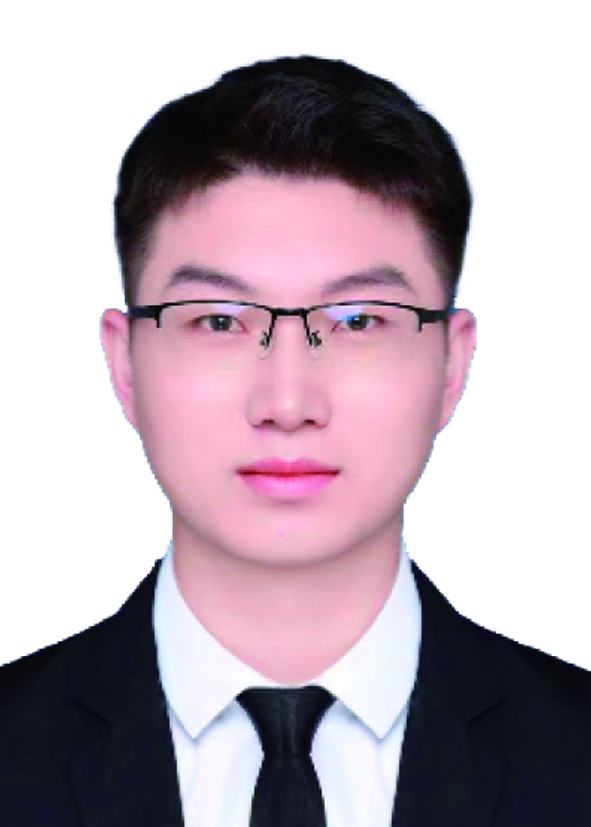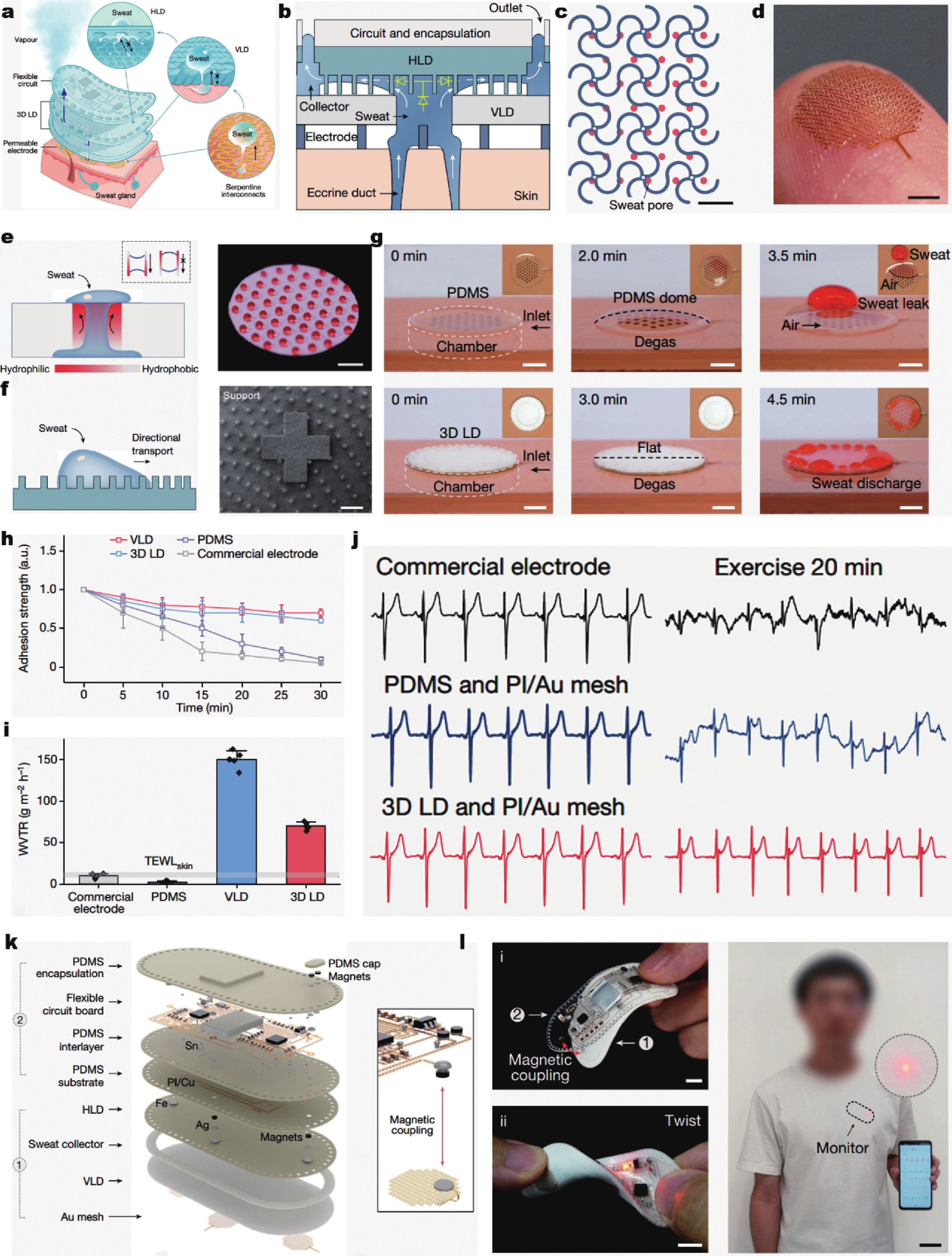| Citation: |
Kangdi Guan, Di Chen, Qilin Hua, Guozhen Shen. Sweat-permeable electronic patches by designing three-dimensional liquid diodes[J]. Journal of Semiconductors, 2024, 45(7): 070401. doi: 10.1088/1674-4926/24040035
****
K D Guan, D Chen, Q L Hua, and G Z Shen, Sweat-permeable electronic patches by designing three-dimensional liquid diodes[J]. J. Semicond., 2024, 45(7), 070401 doi: 10.1088/1674-4926/24040035
|
Sweat-permeable electronic patches by designing three-dimensional liquid diodes
DOI: 10.1088/1674-4926/24040035
More Information
-
References
[1] Yan Z C, Xiong J, Wang B, et al. Recent advances in breathable electronics. Nano Res, 2023, 16, 4130 doi: 10.1007/s12274-022-5039-2[2] Hua Q L, Shen G Z. Low-dimensional nanostructures for monolithic 3D-integrated flexible and stretchable electronics. Chem Soc Rev, 2024, 53, 1316 doi: 10.1039/D3CS00918A[3] Chen F, Huang Q Y, Zheng Z J. Permeable conductors for wearable and on-skin electronics. Small Struct, 2022, 3, 2100135 doi: 10.1002/sstr.202100135[4] Xi J G, Yang H W, Li X Y, et al. Recent advances in tactile sensory systems: Mechanisms, fabrication, and applications. Nanomaterials, 2024, 14, 465 doi: 10.3390/nano14050465[5] Hua Q L, Shen G Z. Full-system-integrated neuro-inspired memristor chips for edge intelligence. Sci Bull, 2023, 68, 3108 doi: 10.1016/j.scib.2023.11.042[6] Li Q S, Chen G, Cui Y J, et al. Highly thermal-wet comfortable and conformal silk-based electrodes for on-skin sensors with sweat tolerance. ACS Nano, 2021, 15, 9955 doi: 10.1021/acsnano.1c01431[7] Ma Z J, Huang Q Y, Xu Q, et al. Permeable superelastic liquid-metal fibre mat enables biocompatible and monolithic stretchable electronics. Nat Mater, 2021, 20, 859 doi: 10.1038/s41563-020-00902-3[8] Jiang Z, Chen N, Yi Z G, et al. A 1.3-micrometre-thick elastic conductor for seamless on-skin and implantable sensors. Nat Electron, 2022, 5, 784 doi: 10.1038/s41928-022-00868-x[9] Shi X, Zuo Y, Zhai P, et al. Large-area display textiles integrated with functional systems. Nature, 2021, 591, 240 doi: 10.1038/s41586-021-03295-8[10] Hua Q L, Shen G Z. A wearable sweat patch for non-invasive and wireless monitoring inflammatory status. J Semicond, 2023, 44, 100401 doi: 10.1088/1674-4926/44/10/100401[11] Yeon H, Lee H, Kim Y, et al. Long-term reliable physical health monitoring by sweat pore-inspired perforated electronic skins. Sci Adv, 2021, 7, eabg8459 doi: 10.1126/sciadv.abg8459[12] Wang Y, Lee S, Wang H Y, et al. Robust, self-adhesive, reinforced polymeric nanofilms enabling gas-permeable dry electrodes for long-term application. Proc Natl Acad Sci USA, 2021, 118, e2111904118 doi: 10.1073/pnas.2111904118[13] Wei R L, Hua Q L, Shen G Z. Wireless multisite sensing systems for continuous physiological monitoring. Sci China Mater, 2024, 1 doi: 10.1007/s40843-024-2910-x[14] Pang H, Hua Q L, Shen G Z. Real-time monitoring of oxygenation in deep brain tissue using a wireless photoelectric probe. Sci China Mater, 2024, 67, 1361 doi: 10.1007/s40843-024-2840-4[15] Nayeem M O G, Lee S, Jin H, et al. All-nanofiber-based, ultrasensitive, gas-permeable mechanoacoustic sensors for continuous long-term heart monitoring. Proc Natl Acad Sci USA, 2020, 117, 7063 doi: 10.1073/pnas.1920911117[16] Zhang B B, Li J Y, Zhou J K, et al. A three-dimensional liquid diode for soft, integrated permeable electronics. Nature, 2024, 628, 84 doi: 10.1038/s41586-024-07161-1 -
Proportional views





 Kangdi Guan received his master's degree in Electronic and Information Engineering at Anhui Normal University in 2023. Currently, he is pursuing further studies at Beijing Institute of Technology. His research focuses on flexible wearable electrochemical sensors and their applications in areas such as health monitoring.
Kangdi Guan received his master's degree in Electronic and Information Engineering at Anhui Normal University in 2023. Currently, he is pursuing further studies at Beijing Institute of Technology. His research focuses on flexible wearable electrochemical sensors and their applications in areas such as health monitoring. Di Chen received her B.S. degree from Anhui Normal University (1999) and a Ph.D. degree from the University of Science and Technology of China (2005). Currently, she is a professor at the Beijing Institute of Technology, China. Her research interests focus on designing nano-structures for sustainable energy applications, including energy storage, solar cells, and photocatalysis.
Di Chen received her B.S. degree from Anhui Normal University (1999) and a Ph.D. degree from the University of Science and Technology of China (2005). Currently, she is a professor at the Beijing Institute of Technology, China. Her research interests focus on designing nano-structures for sustainable energy applications, including energy storage, solar cells, and photocatalysis. Qilin Hua received his Ph.D. degree in Microelectronics at University of Chinese Academy of Sciences (UCAS) in 2016. Then, he worked in Tsinghua University (2016−2018) and Beijing Institute of Nanoenergy and Nanosystems CAS (2018−2022). He is currently an associate professor at Beijing Institute of Technology, China. His research interests focus on flexible/stretchable electronics for neuromorphic sensory systems.
Qilin Hua received his Ph.D. degree in Microelectronics at University of Chinese Academy of Sciences (UCAS) in 2016. Then, he worked in Tsinghua University (2016−2018) and Beijing Institute of Nanoenergy and Nanosystems CAS (2018−2022). He is currently an associate professor at Beijing Institute of Technology, China. His research interests focus on flexible/stretchable electronics for neuromorphic sensory systems. Guozhen Shen received his Ph.D. degree (2003) in Chemistry from University of Science and technology of China. He then conducted research in several countries, including Korea, Japan, US and China. Currently, he is a professor of School of Integrated Circuits and Electronics and director of Institute of Flexible Electronics, Beijing Institute of Technology. His research focused on flexible electronics and printable electronics and their applications in healthcare monitoring, smart robots and related areas.
Guozhen Shen received his Ph.D. degree (2003) in Chemistry from University of Science and technology of China. He then conducted research in several countries, including Korea, Japan, US and China. Currently, he is a professor of School of Integrated Circuits and Electronics and director of Institute of Flexible Electronics, Beijing Institute of Technology. His research focused on flexible electronics and printable electronics and their applications in healthcare monitoring, smart robots and related areas.
 DownLoad:
DownLoad:














